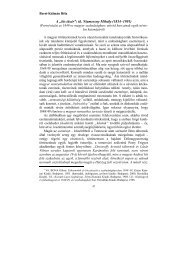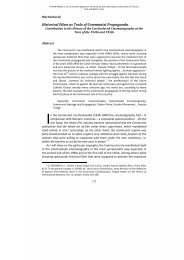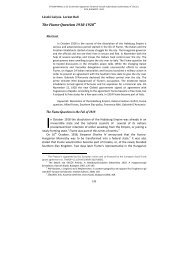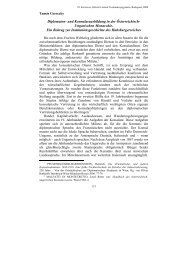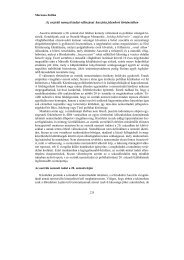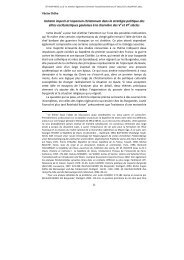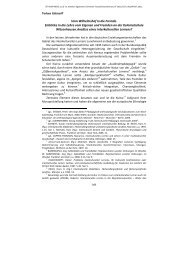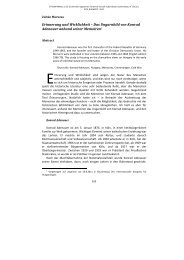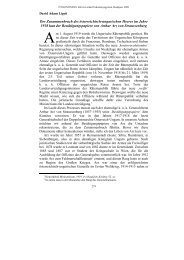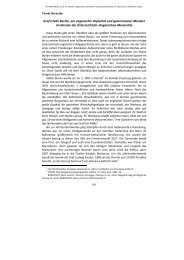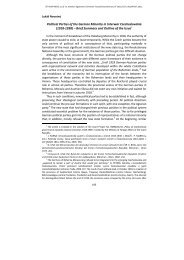The Molotov-Ribbentrop Pact - ELTE BTK Történelem Szakos Portál
The Molotov-Ribbentrop Pact - ELTE BTK Történelem Szakos Portál
The Molotov-Ribbentrop Pact - ELTE BTK Történelem Szakos Portál
Create successful ePaper yourself
Turn your PDF publications into a flip-book with our unique Google optimized e-Paper software.
preoccupation with theory. <strong>The</strong> transition into an operational mode was<br />
already evidenced in Berlin, but most of it took place under Eichmann in<br />
Vienna. From the point of view of the officials in Berlin, Eichmann was the<br />
Vienna representative of II 112, and his principal tasks had not changed:<br />
surveillance of Jewish organizations, study of the enemy, and training other<br />
Nazi bodies in the correct understanding of the Jews. […] While the SD was<br />
looking for channels of operational activity, Eichmann found one, or perhaps,<br />
took advantage of the situation and created one. In the framework of a given<br />
direction of policy set by his superiors, he acted not as drab bureaucrat<br />
carrying out orders, but rather as a very diligent, very violent bureaucrat who<br />
was very successfully taking advantage of a fortuitous moment. His personal<br />
initiative was on such a scale that, even months later, his erstwhile colleagues<br />
in Berlin still did not understand how much he had changed. <strong>The</strong> importance of<br />
this point for our discussion cannot be exaggerated: what put Eichmann at<br />
center stage, and won him rapid promotion, was precisely his ability to<br />
perform on a plane higher than that of a drab bureaucrat.” 53<br />
Adoption of the „Vienna model”<br />
On 12th of November 1938, Göring invited to a conference into the Reich’s<br />
Aviation Museum. On this occasion Heydrich wanted to push through two of<br />
his claims: <strong>The</strong> establishment of a central office of Jewish emigration in Berlin<br />
(„Zentralstelle für jüdische Auswanderung in Berlin”) and the takeover of the<br />
„Jewish policy” of the SD under his leadership. <strong>The</strong> „Vienna model” was<br />
recommended at that meeting in a number of points as a model for the entire<br />
Empire. Heydrich demands were met willingly, after the appalling functionality<br />
of the „Vienna model” has been introduced. 54 <strong>The</strong> central office was approved<br />
as the „Reichszentrale für jüdische Auswanderung” led by Heydrich and was<br />
underpinned by a legal decision of Göring on the 24 th of January 1939. In<br />
October 1939 Eichmann was appointed Head. 55<br />
<strong>The</strong> creation of the „Reich” won Heydrich and the SS, as planned, a senior<br />
position in relation to other instances of the state and the party. For that, they<br />
had an absolute right of say- and decision-making concerning the „Jewish<br />
policy”. In the policy towards Jews was thus the transition from a state of<br />
standards to a state of measures finally completed. 56 But with the nationwide<br />
53<br />
LOZOWICK, Yaacon: Hitler’s Bureaucrats. <strong>The</strong> Nazi security police and the banality<br />
of evil. Leicester, 2002. 38. Lozowick attempted here to demonstrate the initiatives of<br />
Eichmann clearly.<br />
54<br />
At the meeting, Heydrich presented the number of 50.000 Austrian Jews „edited” by the<br />
„Zentralstelle”, compared to 19.000 displaced German Jews from the Altreich.<br />
SMELSER/SYRING. 139.<br />
55<br />
HACHMEISTER, Lutz: Der Gegnerforscher. Die Karriere des SS-Führers Franz Alfred<br />
Six. München, 1998. 188.<br />
56<br />
SAFRIAN, Hans: Eichmann’s Men. 37.<br />
86



